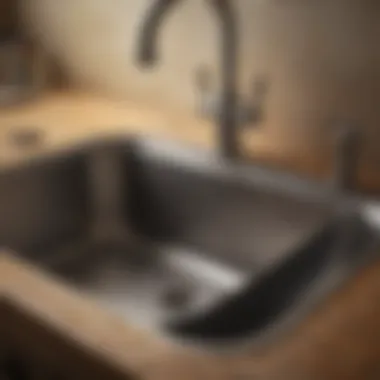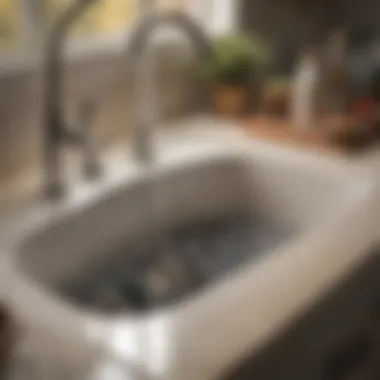Mastering the Art of Unclogging Kitchen Sinks


Intro
Cleaning a clogged kitchen sink drain is a common household challenge. Many people encounter it at some point, often during inconvenient times. Understanding the reasons behind these clogs can help in solving the problem swiftly. Also, knowing the right tools and techniques is crucial in effectively resolving the issue before it escalates. This article sheds light on various strategies for cleaning clogged drains, discusses preventative measures, and suggests when professional help should be considered.
By equipping readers with practical knowledge, the goal is to enhance their ability to manage kitchen plumbing issues efficiently. This not only maintains the functionality of the kitchen but also ensures that the space remains clean and pleasant to use.
Understanding the Kitchen Sink Drain System
Understanding the kitchen sink drain system is essential to maneuvering household plumbing issues. When one comprehends how this system operates, it becomes easier to identify problems, including clogs. Knowing the design and function of kitchen sinks can lead to better maintenance practices and save time and resources in the long run. This section aims to equip the reader with knowledge about the structure and operation of kitchen sink drains.
Anatomy of a Kitchen Sink Drain
The anatomy of a kitchen sink drain involves several critical components. The most visible part is the sink strainer, which sits on the sink’s surface and prevents large objects from entering the drainage system. Below the sink strainer, the tailpiece connects directly to the sink.
Following this is the trap, a curved section that holds water. This water serves as a barrier that prevents foul air from rising through the system. The drain pipe continues from the trap to a larger pipe, which is connected to the home’s main drainage system.
Each of these components plays a vital role in maintaining a smooth workflow in the plumbing system. If any part of the anatomy becomes obstructed or damaged, it can lead to significant issues, like slow drainage or complete blockages. Familiarity with this layout is beneficial for understanding clogs and how to tackle them effectively.
How Drainage Works
Drainage in a kitchen sink relies on gravity and pressure. When water enters the sink, it flows through the strainer, down the tailpiece, and into the trap. Gravity pulls the water downwards, allowing waste to follow through as well. When you turn on the faucet, fresh water enters the sink, pushing the existing water and waste down the drain.
In an ideal scenario, water and waste exit the house smoothly via the larger drainage pipe. This process can get disrupted if there is a buildup of materials, grease, or foreign objects. Understanding this flow is crucial for troubleshooting problems, as recognizing where a blockage might occur can provide insights into solving it efficiently.
"Understanding your kitchen sink drain system is not just technical; it is an essential life skill that can save you from costly repairs."
Moreover, being aware of how drainage works allows homeowners to adopt preventive measures. Taking care not to pour hot grease down the sink or allowing food particles to contribute to buildup can go a long way in keeping the system clear and functional.
Identifying Common Causes of Clogs
Understanding the common causes of clogs is vital for maintaining the functionality of the kitchen sink. Many homeowners face this issue, and recognizing the signs can lead to prompt interventions before they worsen. Effective identification requires an awareness of what typically contributes to drain blockages. This knowledge is beneficial not just for immediate relief but also for preventing future occurrences.
Food Residue Build-Up
One of the primary culprits for clogged kitchen sinks is food residue build-up. This issue often arises when leftover food particles wash down the drain. Over time, these small chunks combine, creating a sludge-like mass. Common scenarios include washing pots and pans with stuck-on food or failing to scrape plates before rinsing. To mitigate this problem, one should make it a habit to dispose of food waste properly in compost bins or trash. Regularly rinsing the plates before cleaning can go a long way in reducing this accumulation. Not addressing this can lead to slow drainage and, ultimately, a complete blockage.
Grease Accumulation


Another major factor is grease accumulation. Cooking oils, fats, and grease often find their way into the sink during food preparation and cleanup. Unlike liquid substances, grease solidifies within pipes, leading to severe clogs. Many individuals may not realize that even indirectly pouring grease down the drain (for example, through water used to rinse greasy pots) contributes to this issue. To combat grease build-up, dispose of used cooking oils in a container and throw them in the trash instead of down the sink. Additionally, using hot water can help manage grease issues while washing dishes but should not replace proper disposal.
Foreign Objects and Debris
Foreign objects and debris frequently contribute to clogs as well. Items such as utensils, food wrappers, and even small toys can accidentally drop into the sink. These objects can obstruct the flow, especially when combined with food residue and grease. Being mindful between sink usage is essential; one should avoid placing any non-biodegradable items near the sink area. A small inspection before and after dishwashing is advisable to catch accidental debris. Should a foreign object cause a problem, using a drain snake or calling for professional help might be necessary.
Identifying the cause of your kitchen sink clogs is an essential step in prevention and maintenance. Knowledge is power when it comes to plumbing.
DIY Methods for Cleaning a Clogged Sink
Cleaning a clogged sink drain can often seem daunting. However, employing DIY methods provides an opportunity for self-sufficiency. Often, simple household items can effectively unclog a sink without requiring an expensive professional service. Understanding these methods not only saves money but also transforms an overwhelming task into a manageable one. The methods explored here will empower you to maintain a clean and functional kitchen sink drain.
Using Boiling Water
Boiling water is perhaps the most straightforward method for tackling your clogged sink. This technique works best for clogs caused by food debris, soap scum, or grease. Here’s how to use this method:
- Boil water in a kettle or pot until it reaches a rolling boil.
- Pour the boiling water slowly down the drain in stages. Allow it to sit for a moment between pours.
- Repeat the process several times if necessary.
The high temperature of the water can dissolve some build-up in the pipes. It’s a fast solution, especially for minor blockages, and can clear away material that is causing slow drainage. Do note that this method may not be appropriate for plastic pipes, as excess heat may cause damage.
Baking Soda and Vinegar Solution
The combination of baking soda and vinegar is a powerful cleaning solution and an eco-friendly option for unclogging sinks. This method uses a chemical reaction between the two substances to break down the clog. Here’s how to utilize it:
- Pour a half cup of baking soda down the drain.
- Follow it with a half cup of white vinegar. This will create bubbling action that acts on the clog.
- Cover the drain with a cloth or stopper to keep the reaction contained.
- After about 20 minutes, flush with hot water.
This mixture not only aids in clearing minor clogs but also helps to deodorize and clean the drain. Additionally, it can be used as a regular maintenance tool to prevent future blockages.
Plunger Techniques
A plunger is a classic tool for drain clearing and can be very effective when used properly. To ensure effectiveness, follow these steps:
- Fill the sink with enough water to cover the plunger cup.
- Position the plunger over the drain, ensuring a tight seal.
- Push down and pull up sharply to create suction. Repeat this motion several times.
The pressure created can dislodge the blockage. If the first attempt doesn’t clear the clog, allow the water to drain, and then repeat the process until the flow is restored. The plunger’s effectiveness largely depends on its ability to maintain a seal over the drain.
Using a Drain Snake
A drain snake is an effective tool for reaching deeper clogs that are not accessible through other methods. Here’s how to properly use one:


- Insert the snake into the drain slowly until you feel resistance.
- Rotate the handle to push the snake deeper and to latch onto the clog.
- Pull the snake out, bringing the clog with it.
- Flush with water to ensure the drain is clear.
While using a drain snake requires a bit of physical effort, it often provides quick results for tough clogs that cannot be resolved with simpler methods. Understanding the mechanics of this tool will enhance your ability to manage a clogged sink effectively.
Preventing Future Clogs
Preventing future clogs is a sensible approach to maintaining the kitchen sink's functionality. Clogged drains can lead to frustrating situations and can sometimes escalate into larger plumbing issues. By implementing preventative strategies, one can ensure a cleaner and more efficient drainage system. Here, we focus on the necessary habits and practices that can significantly reduce the likelihood of clogs in the kitchen sink.
Establishing Proper Disposal Practices
Proper disposal practices are fundamental in minimizing kitchen clogs. Many homeowners may unknowingly dispose of certain materials that contribute to blockages. Here are important points to consider:
- Food Scraps: Avoid putting food scraps directly down the drain. This includes fibrous vegetables and large chunks of food. Instead, use a compost bin or a trash can for disposal.
- Grease: Never pour grease or oil down the sink. Once it cools, it will solidify and adhere to the pipe walls, causing blockages. Use a dedicated container to dispose of cooking oils properly.
- Coffee Grounds: Many people mistakenly believe that coffee grounds are safe for disposal. However, they can form sludge in pipes over time. Discard them in the trash or compost bin instead.
By adopting these practices, the chances of clog formation decrease, leading to a more efficient plumbing system.
Regular Maintenance Tips
Regular maintenance is key in preventing clogs. It's often overlooked, but a little effort can go a long way. Here are some practical maintenance tips:
- Periodic Cleaning: Pour hot water down the drain weekly. This helps dissolve any grease or food residue that may have started to build up.
- Using a Strainer: Employ a sink strainer to catch food particles and debris. This simple tool can save your plumbing from unnecessary strain.
- Schedule Routine Inspections: Check under the sink for leaks or signs of wear. Addressing small issues promptly can prevent more significant problems.
- Use Baking Soda and Vinegar: At least once a month, use a mixture of baking soda and vinegar to clean the pipes. This chemical reaction can help dislodge any minor build-up within the plumbing.
Implementing these maintenance practices can extend the lifespan of your sink and plumbing system, making them invaluable for effective kitchen management.
When to Call a Professional Plumber
Knowing when to call a professional plumber is crucial for maintaining the health of your kitchen plumbing system. While many minor clogs can be fixed with DIY methods, there are situations where professional intervention is not just beneficial, but necessary. This section will discuss vital signs that indicate the need for professional help and how to evaluate the costs versus the benefits of such services.
Signs of a Serious Problem
Several red flags can suggest that your clogged kitchen sink is not a simple issue but rather a serious problem requiring a plumber's expertise. Recognizing these signs early can prevent more extensive damage and save future expenses. Here are some key indicators:
- Persistent Clogs: If you find that the sink gets clogged repeatedly despite your best cleaning efforts, this may signal a more significant issue deeper in the plumbing system.
- Gurgling Noises: Unusual sounds like gurgling from the drain can indicate that air is trapped in the pipes, often a sign of a blockage further down. This could lead to backups or even pipe damage if not addressed promptly.
- Slow Drainage: A sink that drains slowly, even after using common remedies, may suggest a problem that requires professional assessment. Slow drainage can also occur if there is an underlying issue beyond food waste or minor grease accumulation.
- Water Backing Up: If water is flowing back into your sink or other plumbing fixtures, this is a clear indication that there's a blockage somewhere in your plumbing system. Immediate action is necessary to avoid further complications.
- Visible Signs of Water Damage: Stains, wet patches, or mold around the sink area can indicate leakage related to plumbing issues. These conditions may worsen and require extensive repairs if not treated quickly.
- Unpleasant Odors: Foul smells emanating from the sink or drains may indicate decaying food or sewage backup. This should be investigated by a professional as soon as possible.
Addressing these signs early on is essential to mitigate damage and restore proper function to your kitchen sink.
Cost-Benefit Analysis of Professional Help
When considering whether to seek professional plumbing services, it's important to weigh the costs against the potential benefits. While professional help might seem like an expense, especially when DIY fixes could seem cheaper, the long-term savings and benefits often outweigh the initial costs. Here are some factors to consider:


- Expert Assessment: Hiring a professional guarantees that the plumbing issue is accurately diagnosed. Their experience means they can often identify the root cause of the problem, even if it is not immediately apparent.
- Quality of Work: Professional plumbers have the training and tools to perform repairs efficiently and effectively. They can address the issue safely, which minimizes the risk of further damage to your plumbing system.
- Time Savings: Attempting DIY solutions can lead to wasted time and recurring problems. A professional can resolve the issue quickly, allowing you to return to your routine without prolonged interruptions.
- Prevention of Future Problems: A qualified plumber can provide advice on preventative measures, helping you to avoid similar issues in the future. This may include recommendations for routine maintenance or plumbing system upgrades.
- Insurance and Warranties: Many professional services offer warranties on their work. This can provide peace of mind and additional savings should any related issues arise after the service is completed.
Environmental Considerations
Understanding the environmental impact of cleaning a clogged kitchen sink is crucial. This section addresses eco-friendly cleaning options and the overall effect of conventional drain cleaners. Kitchen plumbing practices can affect the environment significantly. Poor choices might lead to pollution of water systems. Being aware of these implications can help make better decisions.
Using Eco-Friendly Solutions
When considering remedies for a clogged drain, eco-friendly solutions are often underestimated. Using natural ingredients can be equally effective without the harsh effects on your plumbing and the environment. Common options include:
- Baking Soda and Vinegar: This solution is well-known. Baking soda helps to break down debris while vinegar enhances its action, creating a fizzy reaction that cleans and deodorizes at the same time.
- Salt and Hot Water: Regular salt, combined with boiling water, can dissolve grease buildup, making it easier to flush away.
- Lemon Juice: Not only does lemon juice offer a pleasant scent, but its acidity also helps break down food residues and grease.
These alternatives work well and minimize your footprint on the environment. Consider these solutions as the first line of defense against clogs.
The Impact of Drain Cleaners on Plumbing and Environment
Commercial drain cleaners often contain corrosive chemicals. While they may provide immediate relief from clogs, they can lead to long-term damage. The chemicals in these products, such as sodium hydroxide or sulfuric acid, can corrode pipes over time. Additionally, when these substances enter the water system, they pose risks to aquatic life and water quality.
Here are some considerations regarding their impact:
- Health Risks: Exposure to these chemicals can be harmful. Proper ventilation is necessary when using them to avoid fumes.
- Environmental Damage: Drain cleaners can contribute to algae blooms in waterways, disrupting local ecosystems.
- Cost Implications: The long-term effects may require costly plumbing repairs that outweigh the convenience of using these cleaners.
In summary, opting for eco-friendly solutions not only protects your plumbing and wallet but also contributes positively to environmental preservation. Making informed cleaning choices supports the overall health of your household and the broader ecosystem.
Culmination
The conclusion serves as a pivotal element in this article, reinforcing the significance of understanding and managing clogged kitchen sink drains. With a kitchen being a central hub of daily activities, ensuring a clear and functional sink is vital not only for convenience but also for maintaining hygiene and preventing more severe plumbing issues.
Summarizing Key Points
In this guide, we have illuminated several key aspects related to kitchen sink drain management:
- Understanding the Anatomy: Recognizing the components of a kitchen sink drain helps in diagnosing potential issues more effectively.
- Identifying Causes: Awareness of common culprits like food residue, grease buildup, and foreign objects allows for proactive measures that can mitigate the risk of severe clogs.
- DIY Cleaning Techniques: The use of simple methods like boiling water, baking soda and vinegar, or a drain snake empowers homeowners to tackle minor issues independently.
- Preventive Strategies: Establishing proper disposal habits and maintaining regular cleaning routines can prevent clogs before they occur.
- When to Seek Help: Recognizing signs of serious plumbing issues is crucial to avoid costly repairs later.
Each point contributes to a holistic approach towards maintaining a clean and functional kitchen sink drain.
Encouragement for Ongoing Maintenance
It is recommended to incorporate ongoing maintenance as part of regular home care. Simple actions such as:
- Regularly cleaning the sink with eco-friendly solutions,
- Avoiding disposal of harmful substances,
- Scheduling periodic plumbing inspections
can significantly enhance the lifespan of your kitchen plumbing.
By taking minor, consistent steps, one can avoid the inconvenience and mess associated with a clogged sink. Without a doubt, maintaining a clean and functional kitchen sink is achievable with the right knowledge and practices. Through diligence, every homeowner can contribute to a smooth and efficient kitchen environment.















